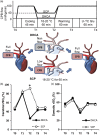Selective cerebral perfusion prevents abnormalities in glutamate cycling and neuronal apoptosis in a model of infant deep hypothermic circulatory arrest and reperfusion
- PMID: 27604310
- PMCID: PMC5094314
- DOI: 10.1177/0271678X16666846
Selective cerebral perfusion prevents abnormalities in glutamate cycling and neuronal apoptosis in a model of infant deep hypothermic circulatory arrest and reperfusion
Abstract
Deep hypothermic circulatory arrest is often required for the repair of complex congenital cardiac defects in infants. However, deep hypothermic circulatory arrest induces neuroapoptosis associated with later development of neurocognitive abnormalities. Selective cerebral perfusion theoretically provides superior neural protection possibly through modifications in cerebral substrate oxidation and closely integrated glutamate cycling. We tested the hypothesis that selective cerebral perfusion modulates glucose utilization, and ameliorates abnormalities in glutamate flux, which occur in association with neuroapoptosis during deep hypothermic circulatory arrest. Eighteen infant male Yorkshire piglets were assigned randomly to two groups of seven (deep hypothermic circulatory arrest or deep hypothermic circulatory arrest with selective cerebral perfusion for 60 minutes at 18℃) and four control pigs without cardiopulmonary bypass support. Carbon-13-labeled glucose as a metabolic tracer was infused, and gas chromatography-mass spectrometry and nuclear magnetic resonance were used for metabolic analysis in the frontal cortex. Following 2.5 h of cerebral reperfusion, we observed similar cerebral adenosine triphosphate levels, absolute levels of lactate and citric acid cycle intermediates, and carbon-13 enrichment among three groups. However, deep hypothermic circulatory arrest induced significant abnormalities in glutamate cycling resulting in reduced glutamate/glutamine and elevated γ-aminobutyric acid/glutamate along with neuroapoptosis, which were all prevented by selective cerebral perfusion. The data suggest that selective cerebral perfusion prevents these modifications in glutamate/glutamine/γ-aminobutyric acid cycling and protects the cerebral cortex from apoptosis.
Keywords: Energy metabolism; apoptosis; glucose; glutamate; magnetic resonance spectroscopy; neurotransmitters; γ-aminobutyric acid.
© The Author(s) 2016.
Figures





Similar articles
-
Is selective antegrade cerebral perfusion superior to retrograde cerebral perfusion for brain protection during deep hypothermic circulatory arrest? Metabolic evidence from microdialysis.Crit Care Med. 2014 May;42(5):e319-28. doi: 10.1097/CCM.0000000000000220. Crit Care Med. 2014. PMID: 24561569
-
Retrograde Cerebral Perfusion Results in Better Perfusion to the Striatum Than the Cerebral Cortex During Deep Hypothermic Circulatory Arrest: A Microdialysis Study.Artif Organs. 2016 Mar;40(3):270-7. doi: 10.1111/aor.12551. Epub 2015 Sep 2. Artif Organs. 2016. PMID: 26333187
-
Effects of moderate versus deep hypothermic circulatory arrest and selective cerebral perfusion on cerebrospinal fluid proteomic profiles in a piglet model of cardiopulmonary bypass.J Thorac Cardiovasc Surg. 2009 Dec;138(6):1290-6. doi: 10.1016/j.jtcvs.2009.06.001. Epub 2009 Jul 29. J Thorac Cardiovasc Surg. 2009. PMID: 19660276
-
Effect of deep hypothermia and circulatory arrest on cerebral blood flow and metabolism.Ann Thorac Surg. 1993 Dec;56(6):1464-6. doi: 10.1016/0003-4975(93)90731-v. Ann Thorac Surg. 1993. PMID: 8267469 Review.
-
Transcranial Doppler monitoring of cerebral perfusion during cardiopulmonary bypass.Ann Thorac Surg. 1993 Dec;56(6):1482-4. doi: 10.1016/0003-4975(93)90735-z. Ann Thorac Surg. 1993. PMID: 8267473 Review.
Cited by
-
Relevance and Recommendations for the Application of Cardioplegic Solutions in Cardiopulmonary Bypass Surgery in Pigs.Biomedicines. 2021 Sep 21;9(9):1279. doi: 10.3390/biomedicines9091279. Biomedicines. 2021. PMID: 34572465 Free PMC article. Review.
-
Anti-apoptotic activity of ETB receptor agonist, IRL-1620, protects neural cells in rats with cerebral ischemia.Sci Rep. 2019 Jul 18;9(1):10439. doi: 10.1038/s41598-019-46203-x. Sci Rep. 2019. PMID: 31320660 Free PMC article.
-
Cardiopulmonary bypass for total aortic arch replacement surgery: A review of three techniques.Front Cardiovasc Med. 2023 Mar 30;10:1109401. doi: 10.3389/fcvm.2023.1109401. eCollection 2023. Front Cardiovasc Med. 2023. PMID: 37063959 Free PMC article. Review.
-
2, 3, 5, 4'-tetrahydroxystilbene-2-O-beta-D-glucoside protects against neuronal cell death and traumatic brain injury-induced pathophysiology.Aging (Albany NY). 2022 Mar 21;14(6):2607-2627. doi: 10.18632/aging.203958. Epub 2022 Mar 21. Aging (Albany NY). 2022. PMID: 35314517 Free PMC article.
-
Right ventricular energy metabolism in a porcine model of acute right ventricular pressure overload after weaning from cardiopulmonary bypass.Physiol Rep. 2022 Nov;10(22):e15421. doi: 10.14814/phy2.15421. Physiol Rep. 2022. PMID: 36394073 Free PMC article.
References
-
- Asou T, Kado H, Imoto Y, et al. Selective cerebral perfusion technique during aortic arch repair in neonates. Ann Thorac Surg 1996; 61: 1546–1548. - PubMed
-
- Pigula FA, Siewers RD, Nemoto EM. Regional perfusion of the brain during neonatal aortic arch reconstruction. J Thorac Cardiovasc Surg 1999; 117: 1023–1024. - PubMed
-
- Ohye RG, Goldberg CS, Donohue J, et al. The quest to optimize neurodevelopmental outcomes in neonatal arch reconstruction: the perfusion techniques we use and why we believe in them. J Thorac Cardiovasc Surg 2009; 137: 803–806. - PubMed
-
- Salazar JD, Coleman RD, Griffith S, et al. Selective cerebral perfusion: real-time evidence of brain oxygen and energy metabolism preservation. Ann Thorac Surg 2009; 88: 162–169. - PubMed
Publication types
MeSH terms
Substances
Grants and funding
LinkOut - more resources
Full Text Sources
Other Literature Sources

